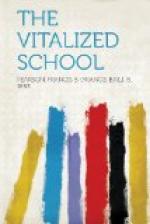=The child’s native interests.=—In brief, she is teaching children and not books or subjects, and the interests of the children take emphatic precedence over her own. She enters into the life of the child and makes excursions into all life according to the dictates of his interests. The child is the big native interest to which she attaches the work of the school. The program is elastic enough to encompass every child in her school. Her program is a garden in which something is growing for each child, and she cultivates every plant with sympathetic care. She considers it no hardship to learn the plant, the animal, the place, or the fact in which the child finds interest. Because of the child and for the sake of the child she invests all these things with the quality of human interest.
=The school and the home.=—Arithmetic, language, history, and geography touch life at a thousand points, and we have but to select the points of contact with the life of each pupil to render any or all of these a vital part of the day’s work and the day’s life. They are not things that are detached from the child’s life. The child’s errand to the shop involves arithmetic, and the vitalized teacher makes this fact a part of the working capital of the school. The dinner table abounds in geography, and the teacher is quick to turn this fact to account in the school. Her fertility of resources, coupled with her vital interest in human beings and human affairs, soon establishes a reciprocal relation between the home and the school. Similarly, she causes the language of the school to flow out into the home, the factory, and the office.
=The skill of the teacher.=—History is not a school affair merely. It is a life affair, and through all the currents of life it may be made to flow. The languages, Latin, German, French, Spanish, are expressions and interpretations of life, and they may be made to appear what they really are if the teacher is resourceful enough and skillful enough to attach them to the life of the pupil by the human ligaments that are ever at hand. Chemistry, physics, botany, and physiology all throb with life if only the teacher can place the fingers of the pupils on their pulses. Given the human teacher, the human child, and the humanized teaching, the vitalized school is inevitable.
QUESTIONS AND EXERCISES
1. What agencies have been employed with the expectation that they would improve the school?
2. What are the reasons why some of these have not accomplished more?
3. Give instances in which the conservatism of teachers seems to have stood in the way of utilizing the element of human interest.
4. What do you think of a teacher who asserts that no important advance has been made in educational theory and practice since, say, 1910?
5. Make an outline of what you think a college of education should do for the school.




